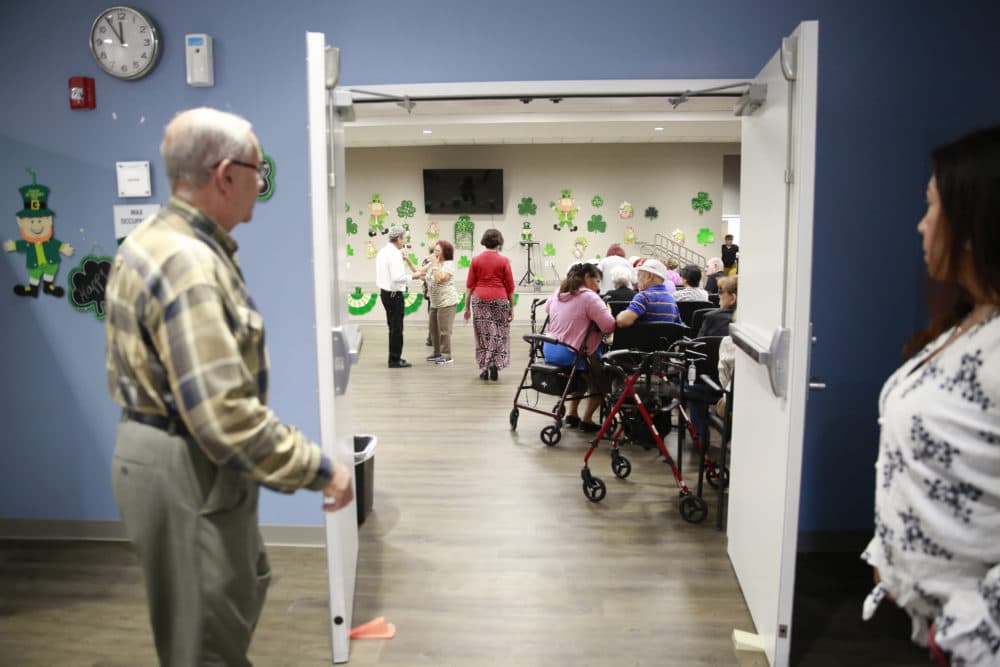Advertisement
As COVID-19 Ravages Care Facilities Families Wonder: 'Should We Bring Them Home?'
Resume
By the end of April, more than 10,000 people died from COVID-19 in long-term care facilities in 23 states in the United States, according to the Kaiser Family Foundation.
It's a terrifying situation for families of the 1.3 million residents who live in these facilities, leaving them to wonder if they should bring their loved ones home. The answer isn't a simple one, says Dr. Thomas Cornwell, executive chairman of the nonprofit Home Centered Care Institute.
“A lot of times we tell our wonderful families that you need a crystal ball to know really what the best decision is,” he says.
While nursing homes are keeping residents in their own rooms, employees could bring the virus in — so bringing patients home could save lives. But caregivers need the ability, skills and time to take care of a patients’ needs, he says.
For example, patients may experience sundowning, which means their days and nights are reversed. Since caregivers need to sleep at night, families experiencing sundowning often turn to nursing homes as a solution, he says.
With 33,000 house calls under his belt from the last 25 years, Cornwell says a lack of medical expertise is rarely a problem for families. He has patients living at home who use complex equipment such as ventilators and feeding tubes.
“It’s more the emotional and the fatigue factor that can come, especially if you have a patient with dementia and behavioral problems,” he says. “That really can just be very, very wearing.”
When it comes to intimate care like using the toilet, washing and dressing, families need to have care conversations to determine whether a patient is comfortable with the family taking care of these personal needs, he says.
While families need to ensure they can meet these needs at home, kids can benefit from seeing their parents take care of their grandparents, he says. With kids home from school, the risk of children transmitting the disease to elderly people in the home has gone down, he says.
Planning is key to transition a patient from a long-term care facility to back home, he says. Along with medicines, patients need durable medical equipment such as hospital beds, wheelchairs, walkers, bedside commodes or shower chairs.
Medicare has loosened the requirement for home health services, he says.
“Part of home health's responsibility is to teach families how to give appropriate caregiving, both in terms of taking care of the patient,” he says, “but also taking care of themselves in the sense that if they're helping the patient to transfer, there's ways to do that so that the wonderful caregiver doesn't get hurt in the process.”
One of Cornwell’s key tips for families bringing a loved one home from a facility is to put their bed in a location other than a bedroom. Perhaps put the bed in a spacious living room with a window so they can look out and use string sheets to create privacy, he says.
“It's just kind of opens their minds to other possibilities,” he says.
Putting their bed on the same floor as a bathroom is also important. Placing a mattress on the floor can prevent hip fractures if the patient falls off, he suggests.
When dementia patients go into nursing homes, short-term memory loss can lead them to wake up every day without knowing where they are or recognizing staff. Cornwell says he’s less concerned about stress from patients transitioning out of nursing homes.
“The nice thing about moving back home is their long-term memory is generally intact so that they'll know the familiar faces,” he says. “They'll hopefully know the home because maybe they had family events in them before.”
The Globe And Mail: "If you can get your relatives out of seniors’ homes, try to do so as fast as you can"
NPR is remembering people who have died of coronavirus as they continued to work outside their homes during the pandemic: health care workers; grocery store clerks; city and town services employees; police; domestic workers; mail carriers; caretakers; those who kept serving others as the rest of us have stayed home.
We'd like to hear a story from you about your lost loved one or friend. Head to npr.org/frontlineworkers to share a special memory you have of this person — it may appear online or on air.
Karyn Miller-Medzon produced and edited this interview for broadcast with Peter O'Dowd. Allison Hagan adapted it for the web.
This segment aired on May 5, 2020.

